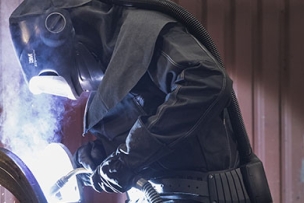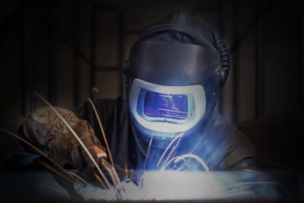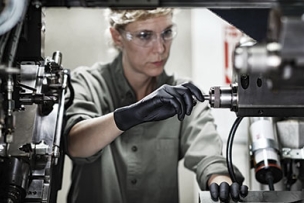Products that work as hard as you do. From the most basic to the most specialized needs, 3M offers the health and safety protection you and your workers need most, so everyone can perform at their best. We strive to deliver comfortable, well-designed personal protective equipment (PPE) that offers your workers the most effective protection available.
This blog article was originally published in October 2020 by 3M and can be viewed here multimedia.3m.com/mws/media/882700O/3m-technical-data-bulletin-182-ppe-during-cleanup-of-residential-wildfire-debris.pdf. It is republished with permission on June 1, 2022.
Description
Proper use of personal protective equipment (PPE) in the aftermath of a wildfire is a critical component in the safe cleanup of fire debris. Selection of PPE depends on both anticipated hazards and the tasks to be performed. In residential cleanup situations, the severity of damage, age of the home and intended remediation must be considered when determining what hazards may be present and the appropriate PPE. PPE must always be used in combination with safe work practices and in accordance with all user instructions and warnings to help ensure a safe cleanup.
Guidance on use of PPE can apply not only to the professional responder or contractor, but also the businesses and homeowners attempting to protect and salvage their property, and the numerous volunteers who are willing participants. As these individuals represent such a diverse group, their knowledge and experience in the use of PPE may vary significantly. At a minimum, a basic understanding of the use and limitations of each type of PPE is necessary. For professional workers falling under the scope of the Occupational Safety and Health Administration (OSHA), specific regulatory requirements apply when using PPE. For others, following basic best practice guidelines will help reduce exposures to wildfire-related hazards. If questions arise concerning the proper use of PPE, refer to the product User Instructions or contact the manufacturer directly.
Potential Cleanup Hazards
Numerous hazards may be present throughout the cleanup process. Prior to beginning the work, certain considerations in addition to the fire damage are necessary to accurately assess all potential hazards. The age of the home may suggest the potential for specific additional hazards, such as lead, asbestos and/or PCB exposures. Homes built prior to 1980 commonly used lead-based paint coatings, asbestos-containing insulation and fireproofing and PCB containing caulks. Other hazardous materials, such as bulk pesticides, paints and fuels (e.g. gasoline, propane), are common in residential areas.
Inhalation and skin contact with mold and mold spores is also a potential hazard during cleanup and restoration phases. In water-damaged homes, mold growth can occur within 48 hours depending on environmental conditions. Jute-backed carpets, vinyl wall covering, drywall and wood products are particularly susceptible.
Using properly qualified contractors to handle and remove materials that contain asbestos, lead, PCBs, large amounts of mold or other hazardous substances may be required by law, and is recommended in order to minimize health risks and ensure proper disposal. Other potential hazards that may commonly be encountered throughout the cleanup include:
• Inhalation, eye and skin contact with:
- Ash, soot and demolition dusts, including those containing hazardous materials.
- Cleaners and disinfectants used during cleaning and restoration.
- Various nuisance dusts, paint/adhesive vapors, etc. throughout the reconstruction.
- Other additional materials that could cause an adverse reaction.
• Operation of carbon monoxide producing equipment (e.g. pumps, generators, pressure washers) in poorly ventilated or confined areas.
• Electrical hazards from downed power lines or water damaged equipment and building electrical systems.
• Ergonomic hazards from repeated lifting, twisting, working on irregular, uneven surfaces.
• Engulfment and atmospheric hazards in open excavation, trenches, and pits.
• Heat stress and cold stress due to work outdoors.
• Fall hazards due to working at elevated heights.
• Slips and trips due to work around unstable, wet and slippery surfaces, uneven terrain and steep grades.
• Any other risks that may arise at the individual scene.
Slips, Trips and Falls
After a significant event, such as a tornado or earthquake, we instinctively want to get back up on our feet and start the recovery process. Part of this includes inspecting damage, cleaning up debris and making the necessary repairs.
During this time, it is critical to protect ourselves and others from slips, trips and falls. As entries are made into affected areas, paths should be cleared to prevent stepping upon or over objects. In areas where the walking surface cannot be seen or where there is standing water, the floor should be checked or prodded before stepping forward. All hazards that cannot be moved should be identified and marked to help others.
When inspecting or repairing roof surfaces, a visual inspection from the ground should be conducted first. Ladders need to be secured to prevent slippage and a personal fall arrest system which includes a full body harness, energy absorber and solid anchor should be employed.
Additional information regarding fall protection can be obtained by calling 3M's customer service line at 651-388-8282 or toll free 800-328-6146.
General Types of PPE
Appropriate selection of personal protective equipment (PPE) and other safety equipment is critical to help control recognized hazards. The following describes the general types of PPE that are commonly applicable to wildfire cleanup. Refer to the end of this document for suggested 3M safety products that may be suitable for these applications.
Respiratory protection may be needed in all phases of natural disaster response. Appropriate selection is needed to assure the correct respirator is being worn for the work environment. In certain situations, the site may present inhalation exposure risk to unknown contaminants. Entry into these areas should be prohibited until adequately characterized.
All respirators used should be tested and certified by the National Institute for Occupational Safety and Health (NIOSH). When selecting a respirator for particulate hazards, a disposable respirator or reusable half/full facepiece with a minimum 95 class particulate filter (e.g., N95, R95, P95) is suitable for most types of dusts. Particulate respirators/filters with an N95, R95 or P95 rating offer a minimum 95% filtration efficiency. Fire or smoke-related odors may require a particulate respirator with additional activated carbon cartridges. Disposable particulate respirators are also available with a carbon layer built-in to help reduce exposure to airborne dusts as well as provide odor relief. For gases and vapors, a reusable respirator with an appropriate cartridge is needed, depending on the specific contaminant.
N95 and other filtering facepiece respirators do not filter all by-products of combustion, such as carbon monoxide, and they do not supply oxygen. They should not be used in confined spaces, where high levels of carbon monoxide or low oxygen levels may be present. A safety professional such as a certified industrial hygienist should be called in to assess these situations and make site specific recommendations.
A higher level of respiratory protection, such as a full facepiece respirator, or Powered Air Purifying Respirator (PAPR) may be needed for certain tasks, such as clean-up in buildings/homes that may contain lead, asbestos, PCB’s and heavy mold contamination. OSHA requires specific respirator selection requirements for lead and asbestos. The US EPA offers guidance in respirator selection for mold. See “References” below.
Respirators must be used in accordance with the OSHA Respiratory Protection Standard, 29 CFR 1910.134. Mandatory use of respirators requires a written respiratory protection program established by the employer. Program elements include selection, employee training, fit testing, medical evaluations, maintenance and inspection, and record-keeping. Any air purifying respirator, which includes disposable, reusable half and full facepiece and PAPRs, should never be used in IDLH (immediately dangerous to life and health) environments. OSHA prohibits use of tight fitting respirators by anyone with facial hair. Refer to the OSHA website at www.osha.gov for a copy of 29 CFR 1910.134.
Cloth face coverings being worn to help slow the spread of Covid-19 are not designed and tested to reduce wearers’ exposure to airborne particulates. If respiratory protection for the wearer is needed, face coverings are not a substitute for a respirator. Per US OSHA, “Cloth face coverings are not considered personal protective equipment (PPE) and are not intended to be used when workers need PPE for protection against exposure to occupational hazards.”
Eye, head and face protection can help reduce the risk of injury due to falling or flying debris, or airborne dusts. Eye and face protection may include safety glasses or goggles and face shields. Use of safety glasses with side shields should be considered minimum eye protection at all natural disaster sites. Unvented or indirectly vented safety goggles may be used for dusty environments or situations where splashing can occur and may fit over prescription eyewear. Safety glasses with a foam seal around the lens area forming a partial seal are also suitable for dusty environments or for environments where debris may be falling or floating in the air. Protective eyewear should meet the requirements of the American National Standards Institute (ANSI) Standard Z87.1 for safety eyewear. As per Z87.1-2015 requirements, impact rated eyewear will be marked “+” or “Z87+”. Protective eyewear will be marked “D3” when designed splash protection and D4 for dust protection. Face shields are considered supplemental protection and should be used only in combination with approved safety glasses or goggles.
Hard hats should meet the requirements of ANSI Standard Z89.1. Look for a sticker or markings on the inside of the hard hat indicating that it meets this standard. The sticker or markings will also state the type and class of hard hat. Type refers to impact performance, with Type I hard hats reducing force of minor impacts from the top resulting from a blow to the top of the head, and Type II hard hats reducing the force of minor impacts resulting from a blow from either the top or side of the head. Class refers to electrical performance. Class G (general) hard hats reduce the danger of contact exposure to low voltage (tested to 2200 volts). Class E (Electrical) hard hats reduce the danger of exposure to high voltage conductors (tested at 20,000 volts). Class C (Conductive) hard hats is not intended to protect against contact with electrical conductors. The type and class of hard hat selected will depend on the anticipated hazards present at the site.
Hearing protection is usually necessary when operating heavy machinery or power tools. Both earplugs and earmuffs are available. Hearing protectors are required under regulation to have a Noise Reduction Rating (NRR), which is the reduction (in decibels) that the hearing protection device (HPD) can provide when worn correctly in a controlled laboratory test. Any individual user may receive less noise reduction than indicated by the NRR due to variation in hearing protector fit, fitting skill and motivation of the user. 3M strongly recommends personal fit testing of hearing protectors. If the NRR is used to estimate typical workplace protection, it is recommended that the NRR be reduced by 50% or in accordance with applicable regulations.
Comfort is also an important factor to consider. If the HPDs are comfortable, they are more likely to be worn and to be worn correctly. Likewise, the hearing protectors must be compatible with the other gear that needs to be worn during a natural disaster response. Selecting a hearing protector that also offers communication capabilities is a vital consideration when both noise attenuation and communication between response workers is needed. Hearing protectors are available that physically connect to portable radio systems, or provide all-in-one, fully contained wireless protective communication solutions. Level-dependent environmental microphones are also available to help wearers maintain important situational awareness and face-to-face communications, while still protecting them from harmful noise levels. Environmental microphone capabilities can commonly include:
• Sampled impulse/impact and steady-state sound levels are limited to 82 dB or less
• Quiet or softer sounds can be amplified
Dual active hearing protection (electronic earmuff with electronic earplugs) will provide a slightly increased level of hearing protection while still allowing audibility and situational awareness.
Protective clothing, gloves, and boots require consideration of the types of anticipated contaminants, and environment/work conditions to be encountered. Selection criteria may need to address both chemical and physical protection. These may include:
• Preventing skin contact, while maintaining durability and dryness.
• Heat and cold stress prevention.
• Worker visibility, particularly in high traffic or low visibility areas.
• Electrical hazards.
• Task specific protective clothing, such as welding and cutting.
Follow the manufacturer’s recommendation for donning of protective clothing, gloves and boots to assure proper fit, performance and comfort.
OSHA regulations, such as confined space, lockout/tagout, and fall protection may also identify other types of safety-related equipment that are required. OSHA fall protection provisions, for example, are applicable when a fall of greater than 4 feet is possible from any improperly guarded walking/working surface. Unlike other PPE that protect specific body areas (e.g., respiratory, hearing, head, eyes, hands, and feet), fall protection equipment is designed to help protect the whole body in the event of a fall. When selecting fall protection for a natural disaster application, careful consideration for the work environment is needed. Hazards typically include unstable shifting materials, sharp edges, and numerous slip/trip/fall conditions. Fall protection equipment may include confined space, rescue systems, body harnesses, ropes/lanyards, and anchorage devices. Use of this equipment requires specialized training that must include information related to intended use, as well as capabilities and limitations.
Suggested 3M Products for Workers
It is always the employer’s responsibility to evaluate PPE needs and to select a proper product for the intended use by workers. Additional or alternative 3M products may be available in addition to those listed. Visit www.3m.com/workersafety for a complete and up-to-date listing.
Response/Recovery
Hearing Protection (Active)
• 3M™ PELTOR™ Tactical Earplug Kit, TEP-100 (active in-ear)
• 3M™ PELTOR™ TacticalPro™ Communications Headset MT15H7F SV (active earmuff)
• 3M™ PELTOR™ Tactical Sport™ Electronic Headset MT16H210F-SV, (active earmuff)
• 3M™ PELTOR™ LiteCom Plus 2-Way Radio Headset
Recovery/Clean-up
Respiratory Protection (Reusable)
• 3M™ 6000 series Half or Full Face Respirator with 2071 P95 or 2091 P100 filters
Respiratory Protection (Disposable)
• 3M™ Particulate Respirator 8210 N95
• 3M™ Particulate Respirator 8511 N95
• 3M™ Particulate Respirator 8247 N95
Eye Protection
• 3M™ SecureFit™ Protective Eyewear 600 Series
• 3M™ Virtua™ CCS Protective Eyewear
• 3M™ Virtua™ AP Protective Eyewear
• 3M™ GoggleGear™ 500 Series
• 3M™ Fectoggles™ Safety Goggles
Head Protection
• 3M™ Hard Hat Series H-700 - cap style
• 3M™ Hard Hat Series H-800 - full brim style
Hearing Protection (Passive)
• 3M™ E-A-R™ EXPRESS™ Pod Plugs™ Earplugs
• 3M™ PELTOR™ X4 Over-the-Head Earmuffs
Protective Clothing
• 3M™ Disposable Protective Coverall Safety Work Wear 4520
Fall Protection
See www.3M.com/FallProtection for a complete list of products.
• Full Body Harnesses
• Confined Space
• Rescue and Descent
This blog article was originally published in October 2020 by 3M and can be viewed here multimedia.3m.com/mws/media/882700O/3m-technical-data-bulletin-182-ppe-during-cleanup-of-residential-wildfire-debris.pdf. It is republished with permission on June 1, 2022.









Talk to Us!
Leave a reply
Your email address will not be published. Required fields are marked *